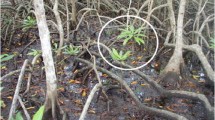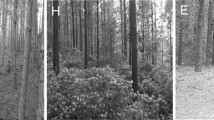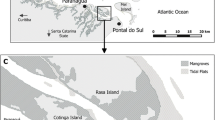Abstract
Predation on propagules ofRhizophora mangle was compared in forests where this species is non-indigenous (Hawai’i, USA) and where it is native (American Samoa). Tree density and basal area of the non-indigenous stand were intermediate when compared to natural stands in other places whereRhizophora is common. Propagules were tethered on the forest floor at both sites for 14 days, predation was recorded, and survival rates of both attacked and control individuals were determined by placing them in a mist room. Mortality was significantly greater in American Samoa (x=25%) than in Hawai’i x=8%). The lower effectiveness of the non-indigenous predators in Hawai’i may help explain the unusually high rate at whichR. mangle propagules become established there.
Similar content being viewed by others
Literature Cited
Allen, J. A. 1998. Mangroves as alien species: the case of Hawaii. Global Ecology and Biogeography Letters 7:83–94.
Cox, E. F., and J. A. Allen. 1999. Stand structure and productivity. of the introducedRhizophora mangle in Hawaii, Estuaries 22: 276–284.
Devoe, N. N., and T. G. Cole. 1998. Growth and yield in mangrove forests of the Federated States of Micronesia. Forest Ecology and Management 103:33–48.
Farnsworth, F. J., and A. M. Ellison. 1997. Global patterns of predispersal propagule predation in mangrove forests. Biotropica 29: 318–330.
Lugo, A. F. and S. C. Snedaker. 1975. Properties of a mangrove forest in south Florida. p. 170–237.In G. Walsh, S. Snedaker, and H. Teas (eds.) Proceedings of International Symposium on Biology and Management of Mangroves. University of Florida. Gainesville, FL, USA.
Putz, E. E. and H. T. Chan. 1986. Tree growth, dynamics and productivity in a mature mangrove forest in Malaysia. Forest Ecology and Management 17:211–230.
Robertson, A. I., R. Giddens, and T. J. Smith III. 1990. Seed predation by insects in tropical mangrove forests extent and effects on seed viability and the growth of seedlings. Oecologia 83:213–219.
Shallenberger, R. J. 1977. An oraithological survey of Hawaiian wetlands. Vol. 1. Ahuimanu Productions for U. S. Army, Engineer District. Honolulu, HL, USA.
Smith, T. J. III. 1987. Seed predation in relation to tree dominance and distribution in mangrove forests. Ecology 68:266–273.
Smith, T. J. III. 1992. Forest structure. p. 101–136.In A. I. Robertson and D. M. Alongi (eds.) Tropical Mangrove Ecosystems. Coastal and Estuarine Studies, 41, American Geophysical Union, Washington, DC, USA.
Smith, T. J. III, H. T. Chan, C. C. Mclvor, and M. B. Robolee. 1989. Comparisons of seed predation in tropical, tidal forests from three continents. Ecology 70:146–151.
U.S. Fish and Wildlife Service, 1985. Recovery plan for Hawaiian waterbirds. Portland, OR, USA.
Wagner, W. L., D. R. Herbst, and S. H. Sohmer. 1990. Manual of the Flowering Plants of Hawai’i. Vol. 2. Bishop Museum Special Publication 83, Honolulu, HI, USA.
Walsh, G. E. 1967. An ecological study of a Hawaiian mangrove swamp. p. 420–431.In G. H. Lauff (ed.) Estuaries. American Association for the Advancement of Science. Publication No. 83.
Author information
Authors and Affiliations
Rights and permissions
About this article
Cite this article
Steele, O.C., Ewel, K.C. & Goldstein, G. The importance of propagule predation in a forest of nonindigenous mangrove trees. Wetlands 19, 705–708 (1999). https://doi.org/10.1007/BF03161706
Received:
Revised:
Accepted:
Issue Date:
DOI: https://doi.org/10.1007/BF03161706




